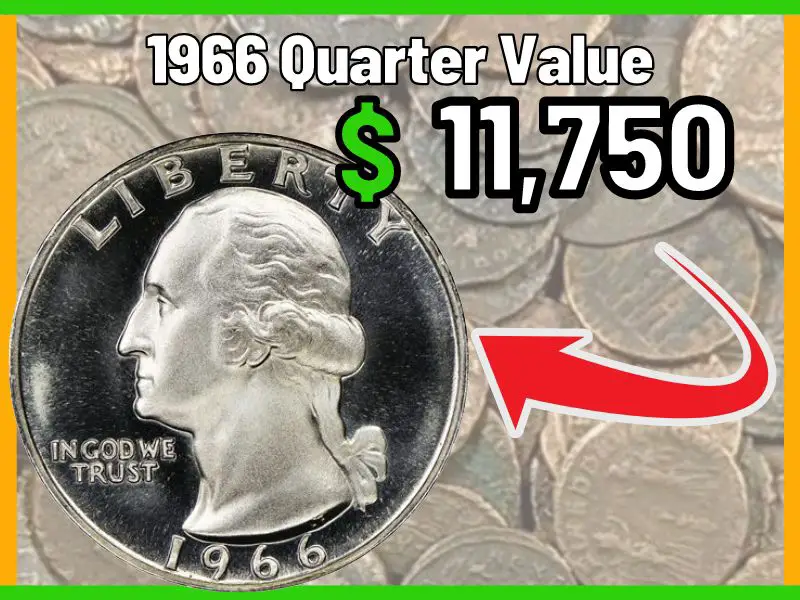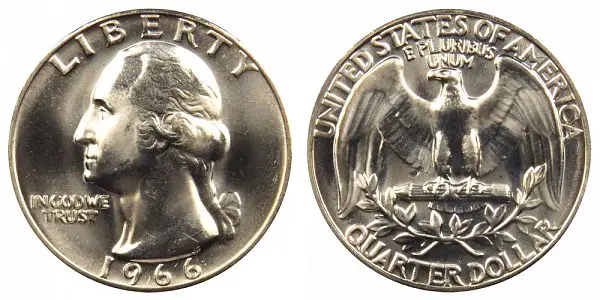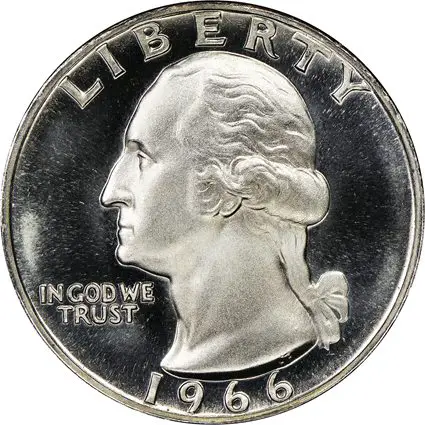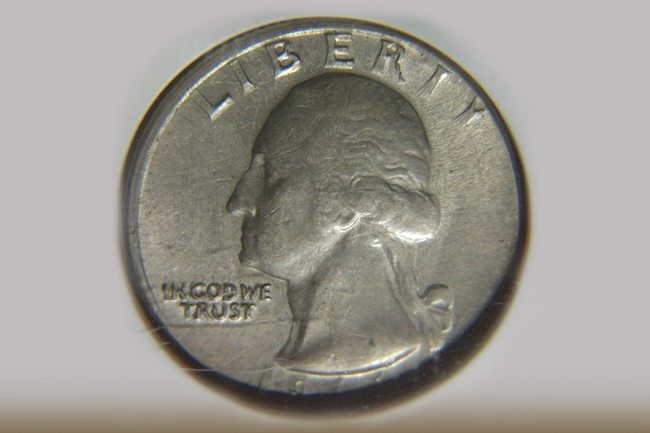
Do you have any old 1966 coins lying around your house? If so, you may be wondering how much they are worth. The quarter was made from copper-nickel clad, which is a less valuable metal. Because so many quarters were made, they are not as valuable as other coins. That is why some people do not want them anymore. However, there are some coins that might be worth more than their face value!
In this blog post, we will explore the history of the 1966 quarter and discuss how much it is worth today. Stay tuned for more information!
What Does a 1966 Quarter Look Like?

If you took a close look at a 1966 quarter, you would notice that it is made of 91.67% copper and 8.33% nickel. It also has a diameter of 24.3 mm and a mass of 5.67 grams. The obverse, or front, of the coin features a profile portrait of President George Washington with the words “United States of America” and “In God We Trust” printed around the edge. The word “Liberty” is also inscribed on the coin.
The reverse, or back, of the coin features an image of an eagle with outstretched wings and the words “E Pluribus Unum” printed below. The date “1966” is also printed on the coin.
The 1966 Quarter is an interesting coin, as it was designed and engraved by John Flanagan. This was the year that dimes and quarters changed from being 90% silver to 0% silver, so it was a year off from a transition year.
1966 quarters don’t have a mint mark. The U.S. Mint stopped putting mint marks on quarters in 1965, because there was a coin shortage at the time and the Mint wanted to increase production. A mint mark is a letter or symbol on a coin that indicates the mint where it was produced. All coins were minted at Philadelphia Mint.
How Rare is a 1966 Quarter?
Contrary to popular belief, a 1996 quarter is not rare. 821,101,500 were minted that year, so there are quite a few in circulation. If you have a 1996 quarter, there’s an excellent chance it’s not worth anything more than 25 cents. Even if it’s in pristine condition, a 1996 quarter is probably only worth its face value.
A major coin shortage in the early 1960s led to a heightened demand for quarters. In addition, the rising value of silver during this time made silver quarters more valuable. As a result, many people began to hoard quarters, leading to a decrease in the supply of coins.
The US Mint solved the problem by debasing the metallic composition of the silver coins and minting many copper-nickel clad coins instead. That is also the reason why there are no mint marks on Washington quarters. Similarly, the US Mint didn’t produce any proof sets or mini sets for collectors.
However, the United States Mint produced a special mint set that included a quarter made of 75% copper and 25% nickel over a pure copper center. A total of 2,200,000 of these quarters were minted, making it one of the more rare coins from the 60s.
Which Washington Quarters are Worth Money?
Despite most coins being worth only their face value, there are some Washington quarters that can be worth a bit more. Here is what you should be looking out for:
- Uncirculated 1966 quarters
- Special Mint Sets
- Washington quarters with errors (Double Die Reverse, Multi Strikes, struck on nickel planchet, struck on dime planchet, struck on cent planchet, and struck through)
- 1996 Silver Quarter Error Coin (Not yet confirmed to exist)
How to Know if You Have a 1966 Silver Quarter Error Coin
Even though 1966 silver quarters aren’t yet officially confirmed to exist, if you’re confident that you have one there are a few things you can do to verify.
A quick and easy way to tell if you have a 1966 silver quarter is to use a scale. A genuine silver quarter from 1996 should weigh about 6.25 grams. However, clad quarters made after 1965 typically weigh 5.67 grams.
Of course, the best way to confirm that your coin is genuine is to take it to a professional numismatist or coin dealer. They will be able to examine your coin and give you a definitive answer.
How Much are 1966 Quarters Worth?
Most 1966 quarters are only worth their face value of $0.25. However, some sought-after varieties can be worth more. If you have a 1996 quarter that is in uncirculated condition with a grade of MS 63, then it is worth around $2. If it is in uncirculated condition with a grade of MS 65, then it is worth around $7.
MS is the abbreviation for “mint state” and grades coins on a 1-70 scale, with 70 being a perfect coin. An MS 63 coin is a coin that has no wear and has full mint luster. An MS 65 coin is a coin that has no more than two small blemishes or scuffs, and has full mint luster. The value of a 1996 quarter decreases if it is not in uncirculated condition or if it has a lower grade.
Let’s take a look at some of the recently sold examples on eBay:
- A circulated 1966 Washington quarter sold for only $1.
- A similar quarter reached the price of $5.
- Two uncirculated 1966 quarters sold for $2.
- A rare 1966 Washington quarter that was graded MS 68 sold for over $1000. This shows how much the condition and grade of a quarter affects its value.
What is the Most Expensive 1966 Quarter Ever Sold?
While most 1966 quarters are only worth their face value of 25 cents, there are a handful that are worth significantly more. The most valuable 1966 quarter ever sold was graded MS68 by Professional Coin Grading Service and took $11,750 in a 2019 auction. This particular coin is believed to be one of few examples that exist in such pristine condition.
How Much is a 1966 SMS Quarter Worth?

1966 SMS Quarter
Some quarters from 1966 were included in Special Mint Sets, which were only available for a limited time. As a result, there are fewer of these quarters in circulation than other types of quarters. They are typically worth at least $2 but have been known to sell for much more.
The most valuable 1966 SMS quarter was sold at auction in 2006 for $3,738. This quarter was graded MS 67 SCAM by Professional Coin Grading Service, indicating that it is in near-perfect condition. Of course, this is a rare example so let’s take a look at some of the more common ones:
- Uncirculated and ungraded Washington SMS quarter sold for $2,37. A similar one sold for $3.
- This SMS quarter reached the price of $10 on eBay.
- A 1966 SMS quarter graded MS66 sold for $10 on Heritage Auctions.
How Much is a 1966 Washington Quarter With an Error Worth?

A small number of 1966 quarters were struck on planchets (blanks) intended for other coins. Due to their scarcity and inherent rarity, they typically sell for high prices.
For example, some quarters were struck on nickel planchets, resulting in coins that were missing a portion of the lettering or numbers on the top or bottom. Others were struck on dime planchets, resulting in coins that were smaller than usual and missing a significant amount of detail. These can sell for around $500.
The average selling price of a 1966 quarter struck on a cent planchet is about $900. While this may seem like a lot of money for a coin, it is important to remember that only a handful of these errors were ever produced.
Die adjustment strike errors are among the most coveted finds for coin collectors. Also known as die trials, these errors occur when a coin is struck from the press with very little pressure. As a result, the detail on the coin is often incomplete or missing altogether.
While die adjustment strike errors are relatively rare, they can command a high price from collectors. For example, a 1966 Washington Quarter Dollar with this error recently sold for $168.
Another great example is this saddle triple strike coin. This means that the second and third strikes are 80% and 90% off center. The coin has been graded as MS64 by PCGS, making it a valuable addition to any collection. This coin was sold for $780, which demonstrates the high demand for such a rare and unique coin.
How Do You Tell if a Coin Is Struck on the Wrong Planchet?
There are a few ways to tell if a coin has been struck on the wrong planchet. First, you can weigh the coin to see if it falls within the correct tolerance. You can also measure the coin to see if it is the correct size. For example, a 1996 quarter should weigh 5.67 grams. If a quarter from that year weighs significantly less or more than that, it may be worth checking out.
Of course, there are other reasons why a coin might be off-weight, so it’s always best to consult with a professional before making any assumptions.
While most errors like this are caught before the coin is struck, there have been cases where the wrong planchet was fed into the coining press and a coin was produced on a smaller or larger blank than intended. These coins are highly sought after by collectors because they are so rare.
Where to Sell a 1966 Quarter
When it comes to selling a 1966 quarter, there are a few different options to consider. One option is to sell the coin on eBay. eBay is a great platform for selling collectible items, and quarters are no exception. In addition to reach a large audience of potential buyers, selling on eBay also offers the benefit of being able to set your own price.
Many cities have at least one coin shop, and these dealers are typically knowledgeable about a wide variety of coins. If you live in a larger city, you may even have several dealers to choose from. You can find the coin dealer near you with the help of American Numismatic Association’s official Coin Dealer Directory.
Another option is to sell the coin through a reputable auction house like Heritage Auctions. Auction houses typically have more expertise in pricing and selling rare coins, and they also have access to a wide network of collectors.
Ultimately, the decision of where to sell a 1966 quarter will come down to personal preference. No matter which route you choose, make sure to research coin values in order to get the best possible price for your coin.
Tips for Selling a 1966 Quarter
If you’re looking to sell your 1966 quarter, here are a few tips to help you get the most out of your sale:
- First and foremost, it’s important to do your research. Look up the current value of your coin and compare it to similar listings. This will give you an idea of what price range you should be aiming for.
- It’s helpful to have your coin appraised by a professional to ensure that you’re getting a fair price.
- Once you’ve settled on a price, it’s time to find a buyer. Whichever route you choose, be sure to read the terms and conditions carefully before listing your coin.
- Be prepared to negotiate; dealers often pay less than the full value of a coin in order to make a profit.
- Finally, remember to take shipping costs into account when setting your price.
With these tips in mind, you should have no trouble selling your 1966 quarter for a great price!
Bottom Line
If you have a 1966 quarter, chances are it’s worth 25 cents. Unless it’s in pristine condition and was part of a Special Mint Set, most 1966 quarters are only worth their face value. However, if your coin does have an error, it could be worth significantly more – hundreds or even thousands of dollars.
There you have it! Everything you need to know about how much a 1966 quarter is worth. We hope this guide has been helpful in providing you with the information you were looking for. Bear in mind that the value of a coin can fluctuate depending on a number of factors, such as its condition, rarity, and popularity. So, if you come across a 1966 quarter that you think might be valuable, it’s always a good idea to do some more research!
